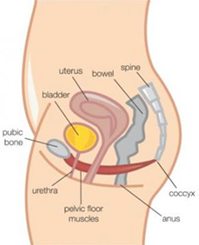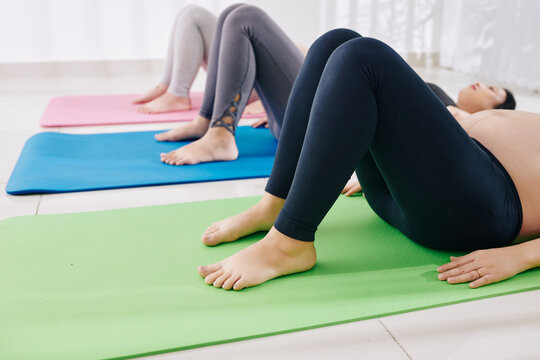What are Pelvic Floor Muscles?
 The floor of the pelvis is made up of layers of muscle and other tissues. These layers stretch like a sling much like a trampoline from the tailbone at the back, to the pubic bone in front. A woman’s pelvic floor muscles support her bladder, womb (uterus) and bowel (colon). The urethra (front passage), the vagina and the rectum (back passage) all pass through the pelvic floor muscles.
The floor of the pelvis is made up of layers of muscle and other tissues. These layers stretch like a sling much like a trampoline from the tailbone at the back, to the pubic bone in front. A woman’s pelvic floor muscles support her bladder, womb (uterus) and bowel (colon). The urethra (front passage), the vagina and the rectum (back passage) all pass through the pelvic floor muscles.
Your pelvic floor muscles help you to:
- Control your bladder and bowel.
- Increase sexual function or response.
- Stabilise your pelvis and spine, as they work in conjunction with your abdominal and back muscles.
It is vital to keep your pelvic floor muscles strong. Although we can’t see the pelvic floor, it is a voluntary muscle, which means that it can be exercised and strengthened, just as you would any other muscles. These exercises are called Pelvic Floor Exercises, and are particularly important for pregnancy.
Why should I do Pelvic Floor Exercises When Pregnant?
For pregnant women, pelvic floor muscle training will help to keep the pelvic floor strong, and assist the body to cope with the growing weight of the baby. Taking the time to ensure these muscles are healthy and fit prior to the baby’s birth, will improve bladder and bowel control following birth and reduce risk of incontinence later in life.
These muscles come under great strain and are stretched during pregnancy and are stretched during birth. Pregnancy hormones also increase flexibility of soft tissues in the pelvis which can lead to leaking when you cough, sneeze, lift or exercise.
How do I find my Pelvic Floor Muscles?
The best way to locate and then train your pelvic floor muscles is to:
- Sit or lie down with the muscles of your thighs, buttocks and stomach relaxed.
- Squeeze your internal muscles as if you are stopping a wee, or tighten the internal ring of muscle around the back passage as if you are trying to stop passing wind. Now relax this muscle. Squeeze and let go a couple of times until you are sure you have found the right muscles. Try not to squeeze your buttocks.
- To test your technique try to stop the stream of urine when sitting on the toilet to empty your bladder, then start it again. Do this to learn which muscles are the right ones to use – but only once a week. Your bladder may not empty the way it should if you stop and start your stream more often than that.
- If you don’t feel a distinct “squeeze and lift” of your pelvic floor muscles, or if you can’t slow your stream of urine, ask for help from your doctor, physiotherapist, or continence nurse. They will help you to get your pelvic floor muscles working right. Women with very weak pelvic floor muscles can benefit from pelvic floor muscle training.
How do I do Pelvic Floor Exercises?
Once you have located the muscles, and can feel them working, you can:
- Squeeze and draw in the muscles around your back passage and your vagina at the same time. Lift them UP inside. When you are pregnant you should have a sense of ‘lift’ each time you squeeze your pelvic floor muscles. During pregnancy it may not be possible to identify a big lift as the muscles are under strain.
- When you release your pelvic floor muscles, you should have a distinct feeling of “letting go”.
- Repeat “tighten and lift” and let go. Aim to do this 10 times, but stop if your muscles get fatigued and have a good rest.
- After resting for 20-30 seconds repeat this “tighten and lift” and hold the muscle activation for 5-10 seconds. Each time you should be able to feel a good release and let go. Rest 5-10 seconds between each lift and hold. Repeat as many times as you can, up to a limit of 10 repetitions.
- Do this whole training plan (5-10 short, and 5-10 holding) 2-3 times each day while lying down, sitting or standing.
Make sure that you:
- Keep breathing
- Tighten and lift, avoiding pushing down
- Keep your buttocks and thighs relaxed
To keep these muscles working well, make pelvic floor exercises part of your routine for the rest of your life. You can start during pregnancy and continue after birth. After the birth of your baby, you should begin pelvic floor muscle training as soon as you can.
Pick an activity that reminds you to do your pelvic floor exercises. Make an activity an anchor for you to remember. Every time I:
- Go to the toilet
- Feed my baby
- Brush my teeth
- Stop at traffic lights
- Take a drink
Thanks to Emily Shiel for the video explaining how to do pelvic floor exercises correctly. Emily is one of our HypnoBirthing Practitioners in Albany WA, as well as a Women’s Health Physiotherapist.
What else can I do to maintain my pelvic floor health?
- Always tighten and hold, or ‘brace’ your pelvic floor muscles before you sneeze, cough or lift your baby.
- Avoid constipation by drinking plenty of fluids (preferably water) and eat fibre rich foods.
- When sitting on the toilet, lean forward. Your knees should be slightly higher than your hips (you could use a small stool or step to rest your feet on). Rest your elbows on your knees or thighs so that your back is straight. Gently bulge your abdomen. Relax your pelvic floor and avoid pushing.
Should everybody do pelvic floor exercises?
Although pelvic floor muscles generally experience extra strain and some weakening during pregnancy, some women can have naturally tighter internal muscles prior to pregnancy. If you have experienced deep pelvic pain associated with sexual intercourse or pain related to using your bowels this can suggest that you may have increased muscle tone in your pelvic floor. If you do have muscle tension or pelvic pain it may be more appropriate for you to practice relaxing your pelvic floor rather than working on strength. A women’s health physiotherapist can assess your pelvic floor muscle tone and provide an individualised pelvic floor programme for you. It is helpful to learn how to relax your pelvic floor for the birth of your baby.
Other women can be more at risk of prolapse during and after pregnancy such as those with hypermobility issues or previously existing prolapse. These women should consult a women’s health physiotherapist for an assessment as they may need specific advice relating to their condition. You may require special instructions for taking care of your pelvic floor.
Getting Professional Help for Your Pelvic Floor
For a list of continence and women’s health or pelvic floor physiotherapists, visit the Australian Physiotherapy Association or call the National Continence Helpline on 1800 33 00 66.
Information sourced from www.continence.org.au










